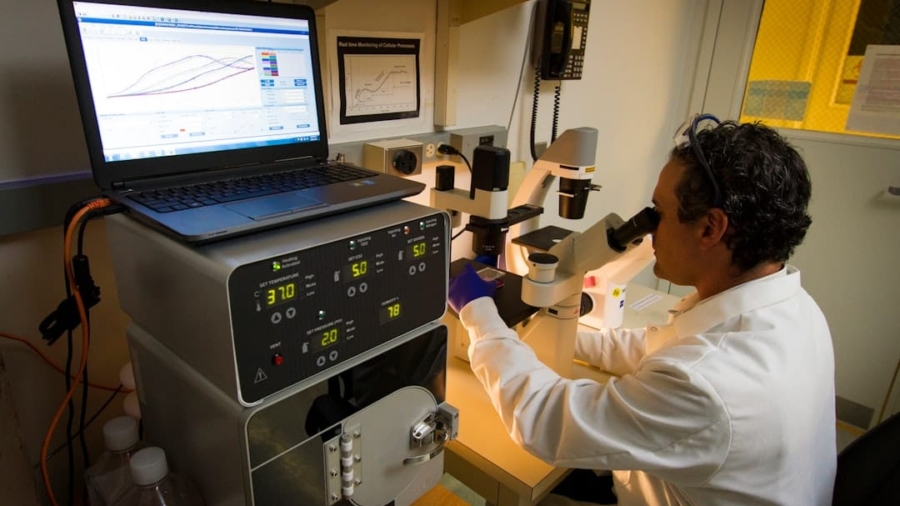The intersection of artificial intelligence (AI) and virology has become increasingly significant in recent years, particularly as the world grapples with the emergence of new viral pathogens.
The COVID-19 pandemic has underscored the urgency of understanding these viruses and their behavior, highlighting the need for innovative approaches to surveillance and response.
AI, with its capacity for processing vast amounts of data and identifying patterns, has emerged as a powerful tool in the fight against these infectious agents.
This capability is crucial for public health officials and researchers who need to respond swiftly to outbreaks.
By leveraging machine learning algorithms and predictive analytics, AI can help identify potential mutations in viruses that may affect transmissibility or virulence, thereby informing vaccine development and public health strategies. The integration of AI into virology represents a paradigm shift in how we understand and combat emerging viral threats.
Key Takeaways
- AI plays a crucial role in tracking mutation patterns of emerging viruses, aiding in early detection and response.
- Understanding mutation patterns is important for predicting the spread and severity of emerging viruses, and AI helps in analyzing and interpreting these patterns.
- AI utilizes advanced algorithms and machine learning to analyze mutation patterns and predict future trends, enabling proactive measures to be taken.
- Case studies have shown AI’s success in tracking mutation patterns of viruses such as COVID-19, Ebola, and Zika, highlighting its potential in managing emerging viruses.
- While AI has shown promise, there are challenges and limitations in tracking mutation patterns, such as data accuracy and ethical considerations, that need to be addressed for its effective use in managing emerging viruses.
The Role of AI in Tracking Mutation Patterns
Limitations of Traditional Methods
Traditional methods of tracking these mutations often rely on labor-intensive laboratory techniques and manual data analysis, which can be slow and prone to human error.
The Power of AI in Mutation Tracking
In contrast, AI can process genomic data at an unprecedented scale and speed, allowing for real-time monitoring of viral evolution. Machine learning algorithms are particularly effective in identifying mutation patterns because they can learn from vast datasets and improve their predictive capabilities over time.
Predicting Future Mutations
This training enables the algorithms to predict how new mutations may arise based on existing genetic information. By continuously updating their models with new data, AI systems can provide insights into how emerging viruses might evolve, which is essential for developing effective vaccines and treatments.
Understanding the Importance of Mutation Patterns in Emerging Viruses

Mutation patterns are critical to understanding the behavior of emerging viruses because they can influence key characteristics such as infectivity, pathogenicity, and immune escape. For example, the emergence of variants of concern during the COVID-19 pandemic highlighted how specific mutations could enhance a virus’s ability to spread or evade immune responses generated by vaccines. Understanding these patterns allows researchers to anticipate potential challenges in controlling outbreaks and to adapt public health measures accordingly.
Moreover, mutation patterns can inform vaccine design and therapeutic strategies. Vaccines are typically developed based on the genetic makeup of a virus at a specific point in time; however, if a virus mutates significantly after a vaccine is developed, the vaccine may become less effective. By tracking mutation patterns, scientists can identify which viral strains are circulating and adjust vaccine formulations to ensure they remain effective against emerging variants.
This proactive approach is essential for maintaining public health safety in the face of rapidly evolving viral threats.
How AI Analyzes and Predicts Mutation Patterns
AI employs various techniques to analyze and predict mutation patterns in emerging viruses, primarily through machine learning and deep learning algorithms. These algorithms can process large datasets that include genomic sequences from different viral strains, epidemiological data, and even social media trends related to outbreaks. By analyzing this multifaceted data, AI can identify correlations and trends that may not be immediately apparent through traditional analytical methods.
One common approach involves using supervised learning algorithms that are trained on labeled datasets containing known mutations and their associated effects on viral behavior. For instance, researchers might input genomic sequences from past outbreaks along with information about transmissibility and severity. The AI model learns to recognize which mutations correlate with specific outcomes.
Once trained, the model can then be applied to new genomic sequences to predict potential mutations and their implications for public health. Additionally, unsupervised learning techniques can be employed to discover novel mutation patterns without prior labeling. These methods allow AI systems to cluster similar viral strains based on genetic similarities, revealing previously unrecognized relationships between different variants.
This capability is particularly valuable in identifying emerging strains that may pose new threats.
Case Studies: AI’s Success in Tracking Mutation Patterns
Several case studies illustrate the successful application of AI in tracking mutation patterns of emerging viruses. One notable example is the use of AI during the COVID-19 pandemic. Researchers at the Massachusetts Institute of Technology (MIT) developed an AI system called “COVID-19 Genomics UK Consortium” (COG-UK) that analyzed genomic sequences from thousands of SARS-CoV-2 samples collected across the United Kingdom.
The system utilized machine learning algorithms to identify mutations associated with increased transmissibility and resistance to neutralization by antibodies. Another significant case study involves the use of AI in tracking influenza virus mutations. Researchers at Google Health collaborated with scientists from Stanford University to develop an AI model that predicts influenza virus strains likely to circulate in upcoming flu seasons.
By analyzing historical genomic data alongside environmental factors such as temperature and humidity, the model successfully identified key mutations that could influence vaccine effectiveness. This predictive capability allowed public health officials to make informed decisions about vaccine formulations ahead of flu season. These case studies demonstrate not only the effectiveness of AI in tracking mutation patterns but also its potential to enhance global preparedness for future viral outbreaks.
By providing timely insights into viral evolution, AI can help guide public health responses and inform vaccine development strategies.
Challenges and Limitations of AI in Tracking Mutation Patterns

Despite its promise, the application of AI in tracking mutation patterns is not without challenges and limitations. One significant hurdle is the quality and availability of data. For AI models to be effective, they require large volumes of high-quality genomic data from diverse populations.
However, disparities in data collection practices across different regions can lead to gaps in knowledge about certain viral strains or mutations. Inadequate data can hinder the ability of AI systems to make accurate predictions. Another challenge lies in the complexity of viral evolution itself.
Viruses do not mutate uniformly; instead, their mutation rates can vary based on numerous factors such as host immune responses, environmental pressures, and transmission dynamics. This variability makes it difficult for AI models to generalize findings across different contexts or predict future mutations accurately. Additionally, there is a risk that over-reliance on AI predictions could lead to complacency in traditional surveillance methods, which remain essential for comprehensive understanding.
Ethical considerations also come into play when using AI in public health contexts. The deployment of AI systems must be accompanied by transparency regarding how data is collected, analyzed, and used. Concerns about privacy and data security are paramount, especially when dealing with sensitive health information.
Ensuring that AI applications adhere to ethical standards is crucial for maintaining public trust and ensuring equitable access to health resources.
The Future of AI in Tracking Mutation Patterns
The future of AI in tracking mutation patterns holds great promise as advancements in technology continue to evolve. One area poised for growth is the integration of real-time genomic surveillance systems powered by AI algorithms. These systems could continuously monitor viral genomes from various sources—such as hospitals, laboratories, and even wastewater samples—allowing for rapid detection of emerging variants as they arise.
Furthermore, advancements in natural language processing (NLP) could enhance AI’s ability to analyze unstructured data sources such as scientific literature or social media posts related to outbreaks. By synthesizing information from diverse channels, AI could provide a more comprehensive understanding of how viruses are spreading and evolving within communities. Collaboration between researchers, public health officials, and technology companies will be essential for maximizing the potential of AI in this field.
Initiatives that promote data sharing across borders will enable more robust datasets for training AI models, ultimately leading to better predictive capabilities. As we continue to face new viral threats, harnessing the power of AI will be critical for developing effective strategies for prevention and response.
The Potential Impact of AI on Managing Emerging Viruses
The integration of artificial intelligence into virology represents a transformative approach to managing emerging viruses. By enabling rapid analysis of mutation patterns and providing predictive insights into viral behavior, AI has the potential to revolutionize public health responses to infectious disease outbreaks. As we have seen through various case studies, AI’s ability to process vast amounts of data quickly allows researchers and health officials to stay one step ahead of evolving threats.
However, realizing this potential requires addressing challenges related to data quality, ethical considerations, and the inherent complexities of viral evolution. As technology continues to advance and collaborative efforts expand globally, the future looks promising for leveraging AI in tracking mutation patterns of emerging viruses. Ultimately, this innovative approach could play a crucial role in safeguarding public health against future pandemics and ensuring a more resilient response framework for infectious diseases worldwide.
In a related article,

